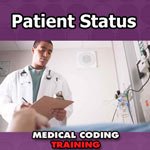There can be confusion in patient status sometimes when medical coding. If you work for a hospital that does both outpatient and inpatient services you need to know the differences. For the most part the division is easy to follow. Outpatient status is anything done in the physician’s office but this can get confusing when dealing with surgery centers. The lingo seems to change which can cause some of the confusion.
Medical Coding Patient Status In A Nutshell
You may have heard the terms same day surgery or ambulatory surgery which also refer to the outpatient setting. With the increase in technology and ability for procedures to be done quickly with less invasive measures there has been an increase in outpatient services. Procedures that had once been open, now can be done laparoscopic which allows the patient to have treatment early in the day and go home that afternoon or evening. Such procedures that fall into this category are as follows:[1]
- colonoscopy (colon exam)
- cystoscopy (bladder exam
- gastroscopy (upper gastrointestinal exam)
- laparoscopy (abdominal exam or surgery)
- laparoscopic cholecystectomies (gall bladder removal)
- myringotomy (ear tube insertion)
- tonsillectomy (removal of tonsils)
- tendon repair (repair of damaged tendons)
- arthroscopy (joint examination or surgery)
- ovarian cystectomy (removal of cyst (s) on ovaries)
- D and C (dilatation and curettage or uterine scraping)
- breast biopsy (removal of tissue for examination)
- hernia repair
The inpatient status can be due to a procedure that is being done or treatment of a disease process. There is no time limit to an inpatient stay. There are separate evaluation and management codes for outpatient services and an inpatient stay. These include initial evaluations, subsequent and discharge codes.
The CPT® manual does a very thorough job of explaining the details involved in choosing the proper codes for both the outpatient and inpatient service. The guidelines provided will take you step by step in the process of choosing the correct evaluation and management code (E/M code). It is important to have an excellent understanding of these E/M codes when working in both the outpatient and inpatient setting. Take advantage of resources available to you to increase your knowledge. Connect with other coders in forums and at your local coding chapter meetings. Knowledge is the key.
![[CCO] Certification Coaching Organization LLC [CCO] Certification Coaching Organization LLC](https://www.cco.us/wp-content/uploads/2015/05/CCO-Logo-2015-d3-500px.png)

Hi Laureen, I used your blitz course and it got me certified ! Now I am interviewing at a large Denver hospital. Im thinking I need more inpatient knowledge, STAT ! Watcha got that I can get online right now? My interview will be next week so there isn’t much time I just wanted something I can poke around on this weekend so I don’t sound like a bafoone! Ok too late for that I guess but what quickie reviews do u have that I can log into online without waiting for a physical CD to be snail mailed?
Im all ears (i’m sure there is an inpatient code for that ..right?
Jodie Brown CPC-A
Hi Jodie,
We don’t have CCS yet – it’s on the list for January 2014. In the meantime here is a link to CCS prep resources I reccomend https://www.cco.us/forum/threads/list-for-ccs-resources.271/